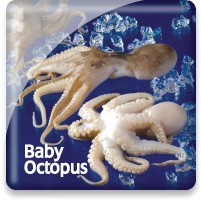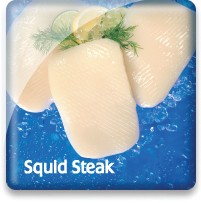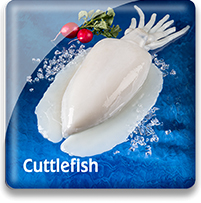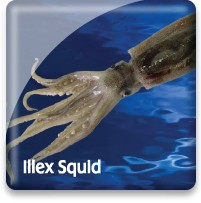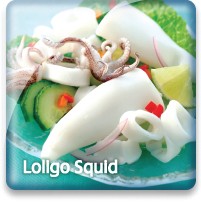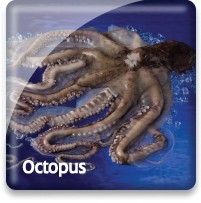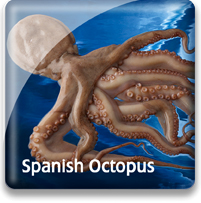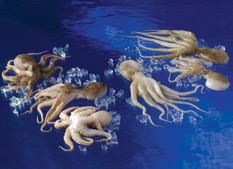
Baby Octopus

Market Name: Eating QualitiesRaw octopus should smell like a fresh ocean breeze and will vary in color with the head and topside of the legs being gray to brown and the underside of the legs and mouth area (where the hard beak is) being white to pink-purple. Cooked octopus is sweet in flavor and becomes more firm in texture. If overcooked, the flesh will become rubbery and lose its flavor, however. All parts of the baby octopus can be consumed except for the beak (hard mouth structure). Cook prior to consumption.
   |
Description & Characteristics"Baby Octopus" is the marketing name for several species of small octopuses that are actually fully grown adults. Just like larger octopus species, they have eight arms or tentacles covered with suction cups. Octopuses are the most intelligent invertebrates exhibiting many cognitive behaviors dealing with building structures, hunting, and navigation. Baby Octopuses are distributed throughout Asia.
An adult octopus can squeeze through a hole the size of a dime.
Other Resources |
Handling Instructions for Baby Octopus
Our whole octopus is sourced from the Philippines, Indonesia, Thailand, Vietnam and Japan is offered in both raw and fully cooked (from Japan) and in sizes ranging from as small as an ounce to more than 13 pounds. Regardless of the origin or size of our whole octopus the proper handling instructions are the same. Our frozen octopus must be stored at or below 0°F (-18°C) and then thawed properly when ready to cook or to eat in the case of our precooked Japanese product. The octopus should be stored in the freezer in the original package or in plastic wrap or a tight fitting plastic bag for product that has been removed from the original packaging. This will help prevent freezer burn (dehydration). Our IQF octopus has an 18 month frozen shelf life and our block frozen has a 24 month frozen shelf life. Links to proper seafood handling instructions: NOAA - Fish Watch: Handling Seafood and A Consumer Guide to Safe Seafood Handling.
Thawing Baby Octopus
Whole octopus can be thawed under refrigeration between 33 and 39°F until it is completely thawed. The thawing time is dependent upon if the octopus is IQF or block frozen. IQF octopus will thaw between 24 and 48 hours depending upon the size of the octopus and block frozen will take up to 48 hours or longer. However, IQF and block frozen octopus can be quickly thawed by placing the product in a colander and running under cold water until thawed. In general, IQF octopus will thaw within several minutes while the block frozen may take 10 to 20 minutes or longer. This is our preferred quick thawing method to use whenever possible.
Important Instructions for Baby Octopus
Thawed raw octopus should be used immediately or within 1-2 days due to the fact that octopus in general has a relatively short thawed shelf life.
Cooking Tips
Whole raw octopus can be challenging to cook to a tender pleasing texture. This is especially true for the larger sizes that can run over 13 pounds. The smaller sized octopuses running less than 1/4th of a pound are less complicated to prepare. However, larger whole octopuses need to be boiled and tested periodically for tenderness during the cooking process. Because of this, our conveniently precooked octopus from Japan is gaining in popularity. Links to cooking tips and recipes: Fish & Seafood Cooking and Recipes
Thailand
With more than 1,550 miles of coastline, Thailand—officially, the Kingdom of Thailand—has become one of the world’s leading seafood suppliers. Primary seafood products from Thailand include cultured (farmed) shrimp sold in various value-added forms as well as canned seafood—predominantly tuna.
With a focus on constant improvement of shrimp farming techniques to reduce impacts on the environment, as well as the development of new, value-added products, Thailand has emerged over the years as one of the leaders in this beloved seafood category.
In the tuna category, Thailand is a major global producer of canned tuna, much of it caught by vessels from other countries that bring it, frozen, to Thailand to be canned.
Vietnam
With a coastline of 2,140 miles, as well as numerous rivers and lakes, Vietnam has had a long tradition of fishing and a culinary tradition that includes finfish, shellfish, and molluscan shellfish.
Bordering China in the far North, and Laos and Cambodia in the middle and Southern regions, the country—known officially as the Socialist Republic of Vietnam—is divided into 58 provinces, and includes several major sea ports.
With seafood production surpassing USD $6 billion in 2012, seafood—both cultured and wild—represents an important export for this developing country.
Major seafood exports from Vietnam include cultured and wild shrimp: Black Tiger prawns and Penaeus vannamei are grown in Southeast Vietnam, and small white and pink shrimp are still commercially caught in the South China Sea off the southern coast.
In addition, Vietnam is becoming known for its high-tech seafood processing industry, adding value to commercially harvested and farmed fish and seafood.
Species that are commercially caught include Grouper, Red Snapper, Red Mullet, Tuna, Swordfish, and Barramundi—which are the major species that are exported to Australia, the United States, and the EU. Vietnam is also a major producer of farmed Tilapia, and two species of Pangisius (boucourti and hypothalamus). Squid and octopus, as well as various species of lobster and crab and molluscan shellfish are also major export products as well as products consumed in-country.
India
The most populous democracy in the world, India has 1.2 billion people living in an area that is the world’s seventh-largest land mass. Bordering the countries of Pakistan, China, Nepal, Bhutan, Burma, and Bangladesh, India includes breathtakingly beautiful mountainous regions, plains, rivers (such as the legendary Ganges River), and valleys—and a coastline of 4,700 miles.
Within Indian marine waters, commercial species such as mackerel, sardines, shark, perch, tuna, shrimp, and cuttlefish are some of the main species harvested. Freshwater fish include carp and catfish and there are several species of brackish water fish.
India’s Exclusive Economic Zone (EEZ) encompasses more than 2 million square kilometer, so there is a huge potential within India, provided that the fishery is managed to thwart overexploitation of the resource.
Top export items from India include frozen shrimp (the dominant seafood export), and frozen lobster tails, to name a few.
Aquaculture in India is growing in importance, however, and in addition to producing carp and giant river prawn for in-country consumption, India has begun to grow and export warm brackish water shrimp as well.
Go Blue! Seafood Sustainability Spectrum*Click here for an explanation of our Sustainability Spectrum Sustainability AssessmentBaby Octopus is the marketing name for the small Asian octopuses Amphioctopus spp., Octopus dollfusi, O. ocellatus & O. membranaceus which are not actually a baby octopuses, but rather fully grown adults. Methods of capturing Baby Octopus are diving, trapping, and primarily trawling. Common concerns that exist in many octopus fisheries are:
The artisanal nature of many of the fisheries makes data collection and enforcement of regulations (where they exist) difficult. Because most octopus species have many offspring and grow to reproductive age quickly, their populations are thought to be inherently resilient to moderate levels of fishing pressure. However, without biomass estimates, it is difficult to determine if current fishing levels are sustainable. The abundance of octopus may also be closely tied to local environmental conditions such as water temperature and pollution. Changes in these environmental conditions, in combination with excessive fishing, may deplete octopus populations. Because there are many unknowns, it would be beneficial to encourage increased data collection. These data could ultimately aid fisheries managers in better assessing the current state of the octopus fishery and determining what regulations may be necessary to ensure healthy populations in the future.
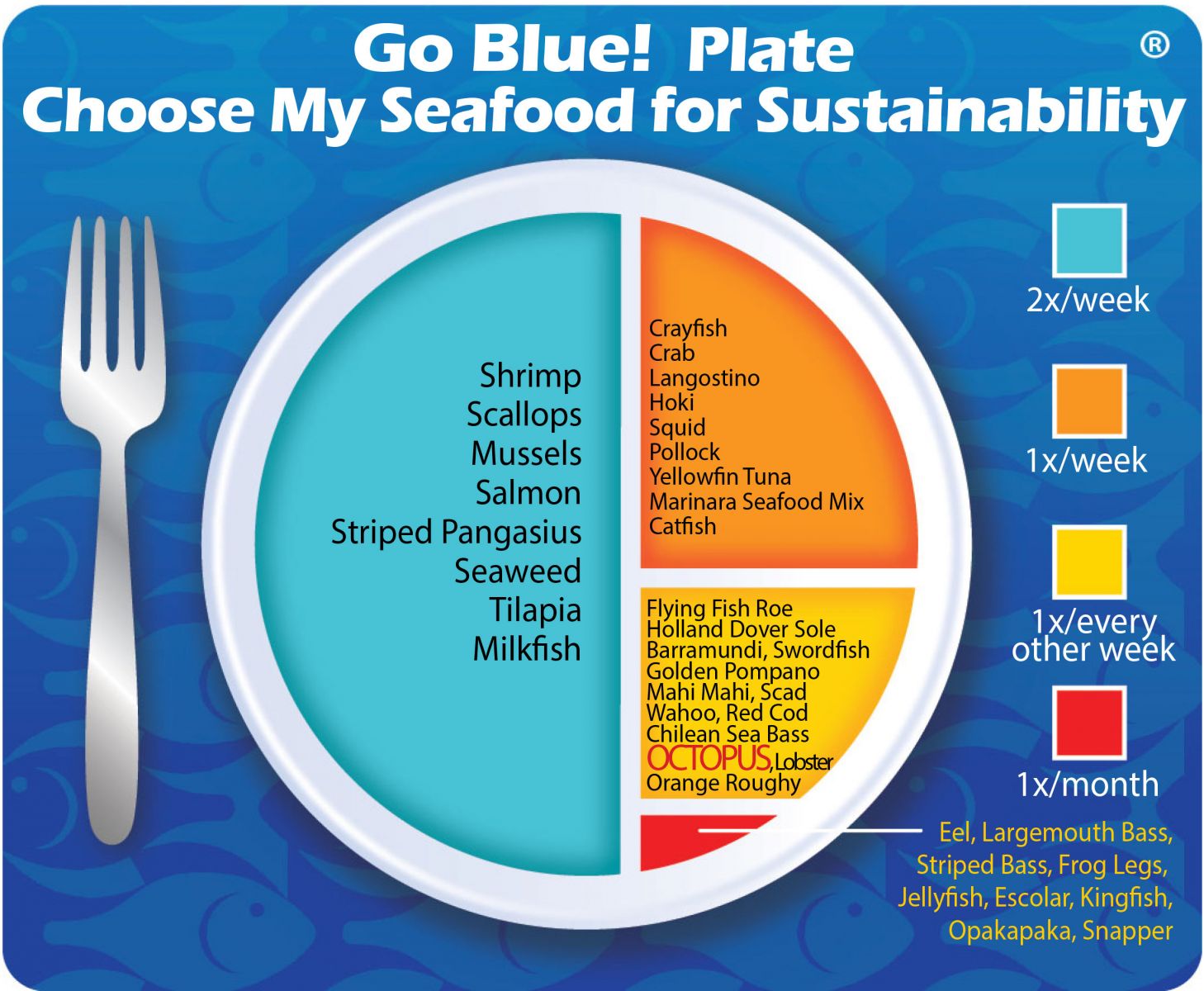
Environmental Impact: Low to Moderately highLack of information about their ecological role as well as outstanding questions about the connections between local environmental conditions and population health make robust assessments of the Baby Octopus fishery difficult. Many octopus fisheries also exhibit a serious lack of regulation and /or enforcement. Damage to ocean floor habitats is an ongoing concern.
Sustainability Improvements NeededThere is a need for more data and information on octopus from fisheries (e.g., location, landings, fishing effort, size of octopus being caught) as well as from scientists (e.g., ecological role of octopus, reproductive strategies). This information can be used to assess the current state of the octopus resource as well as determining what regulations may be necessary to sustain healthy populations.
Actions that Sea Port is UndertakingSea Port is requiring that their suppliers provide fishing vessel identification (when available), catch methodology, and catch area information. In doing so, Sea Port hopes to encourage the Baby Octopus fishery to collect additional harvest data which could set the stage for future fishery management improvements. Sea Port believes that the artisanal “sea shell method” of fishing impacts the marine environment much less than trawling and they are encouraging that this method replace trawling for Baby octopus whenever possible. Sea Port also believes that, in aggregate, choosing from a diverse variety of seafood is better for sustaining the world’s seafood resources and baby octopus should be a part of this variety.
We created the sustainability assessments for each of our seafood items in order to reveal the existing and potential environmental impacts and risks that are associated with producing them for human consumption. This allowed us to establish the starting position for each of our seafood items along our progressive Go Blue! Seafood Sustainability Spectrum®. These assessments are only a single snapshot in time and because of this, we will continue to assess and update the critical sustainability needs associated with our supply sources and issue updates to the Go Blue! Seafood Sustainability Spectrum® as needed. There is a growing global awareness for the need to assure the sustainability of farmed and wild caught seafood and because of this; all around the world positive changes are rapidly occurring at all levels of the seafood supply chain. We will continue to spread this growing awareness and work with our many industry partners to improve the sustainability of all seafood, which we believe is the ideal protein of choice to feed an ever growing world population. Our Go Blue! Seafood Sustainability Spectrum® serves as our compass and yardstick as we strive to move all our products forward to becoming more sustainable. Please join us in this committed quest and Catch Our Wave® to sustainability by choosing a diverse variety of responsibly produced seafood as part of your diet.
|



